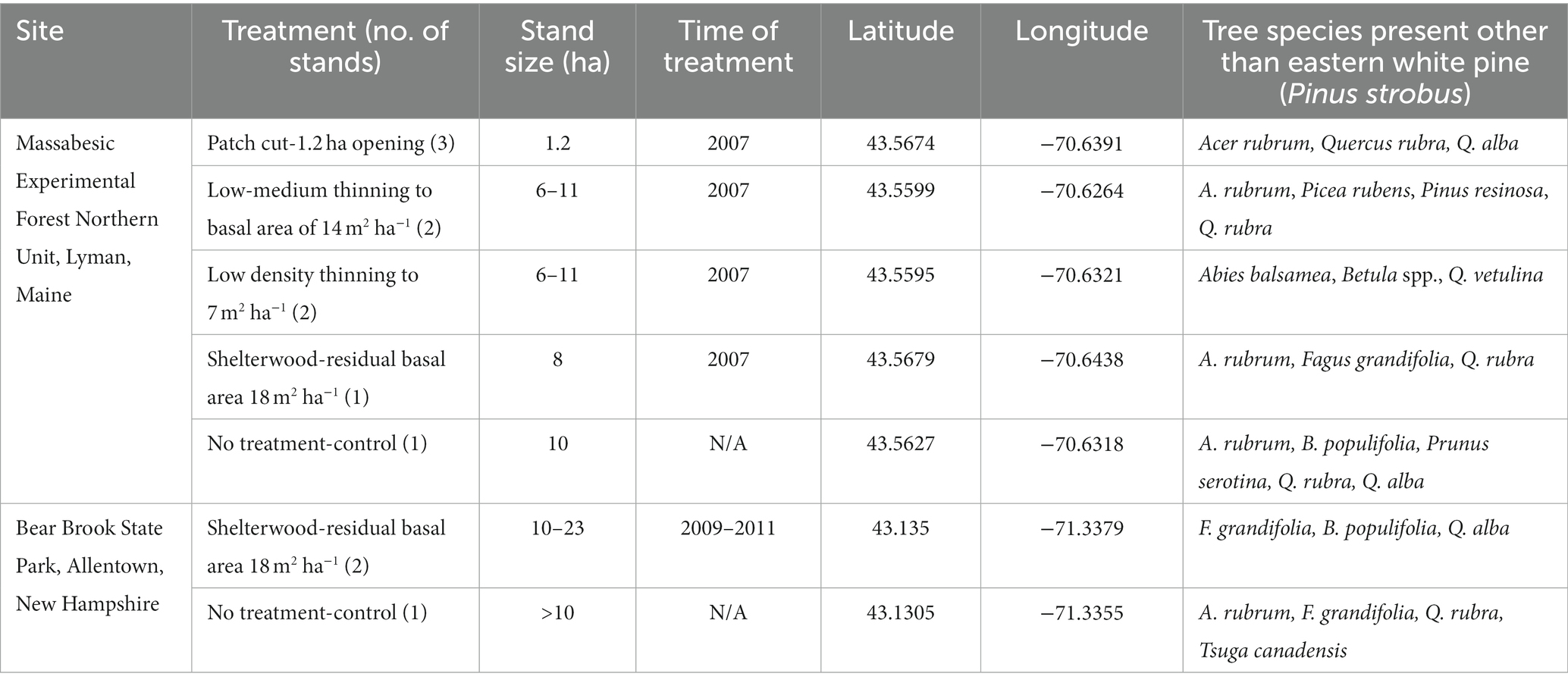- 1Forest Health Protection, State, Private, and Tribal Forestry, USDA Forest Service, Durham, NH, United States
- 2Northern Research Station, USDA Forest Service, Durham, NH, United States
Managing multiple forest insect pests and diseases is challenging. For example, in eastern white pine (Pinus strobus) stands whereas partial shading and high seedling density is encouraged to reduce damage by white pine blister rust (Cronartium ribicola) and white pine weevil (Pissodes strobi), dense conditions in the understory may increase damage by foliar diseases such as brown spot needle blight (Lecanosticta acicola) and Caliciopsis canker (Caliciopsis pinea). We evaluated the effect of silvicultural treatments, shelterwoods (residual basal area < 18 m2 ha−1), low density thinnings (residual basal area ≤ 14 m2 ha−1), patch cuts (1.2 ha openings), and untreated controls on damage by these insect pest and diseases in residual overstory trees and regeneration. Shelterwoods and low density thinnings provided a good balance of some shading and reduced stem density, which resulted in less weevil damage and foliar disease severity. Crown condition and quality of regeneration was better in all treatments compared to unmanaged controls. Shelterwoods, low density thinnings and patch cuts have the added benefit on increasing seral habitat, resulting in greater songbird diversity.
1. Introduction
Eastern white pine (Pinus strobus) is an ecologically and commercially important species in Eastern North America (Costanza et al., 2018). For example, more than 150 vertebrate wildlife species use white pine stands for habitat in Eastern USA (Yamasaki, 2003; DeGraaf et al., 2006; Leak et al., 2020). White pine stands are maintained with silvicultural treatments such as shelterwoods, crown thinnings, or patch cuts (Lancaster and Leak, 1978; Seymour, 2007; Ostry et al., 2010; Leak and Yamasaki, 2013). Shelterwoods are a series of forest cuttings to remove overstory trees and promote seedling establishment by scarifying the soil and providing partial shade before the final and complete removal of the overstory (Table 1; Figure 1) (Lancaster and Leak, 1978). Thinnings are like shelterwoods because overstory trees are removed. However, the objective of a thinning is to increase growth of residual trees, whereas the objective of a shelterwood is to regenerate the stand. Patch cuts are small clearcuts where the overstory is completely removed in 1.2 ha (Table 1; Figure 1). These silvicultural treatments also create ephemeral early successional habitat needed by some bird species (Costello et al., 2000; Thompson and DeGraaf, 2001; DeGraaf and Yamasaki, 2003; Yamasaki et al., 2014).
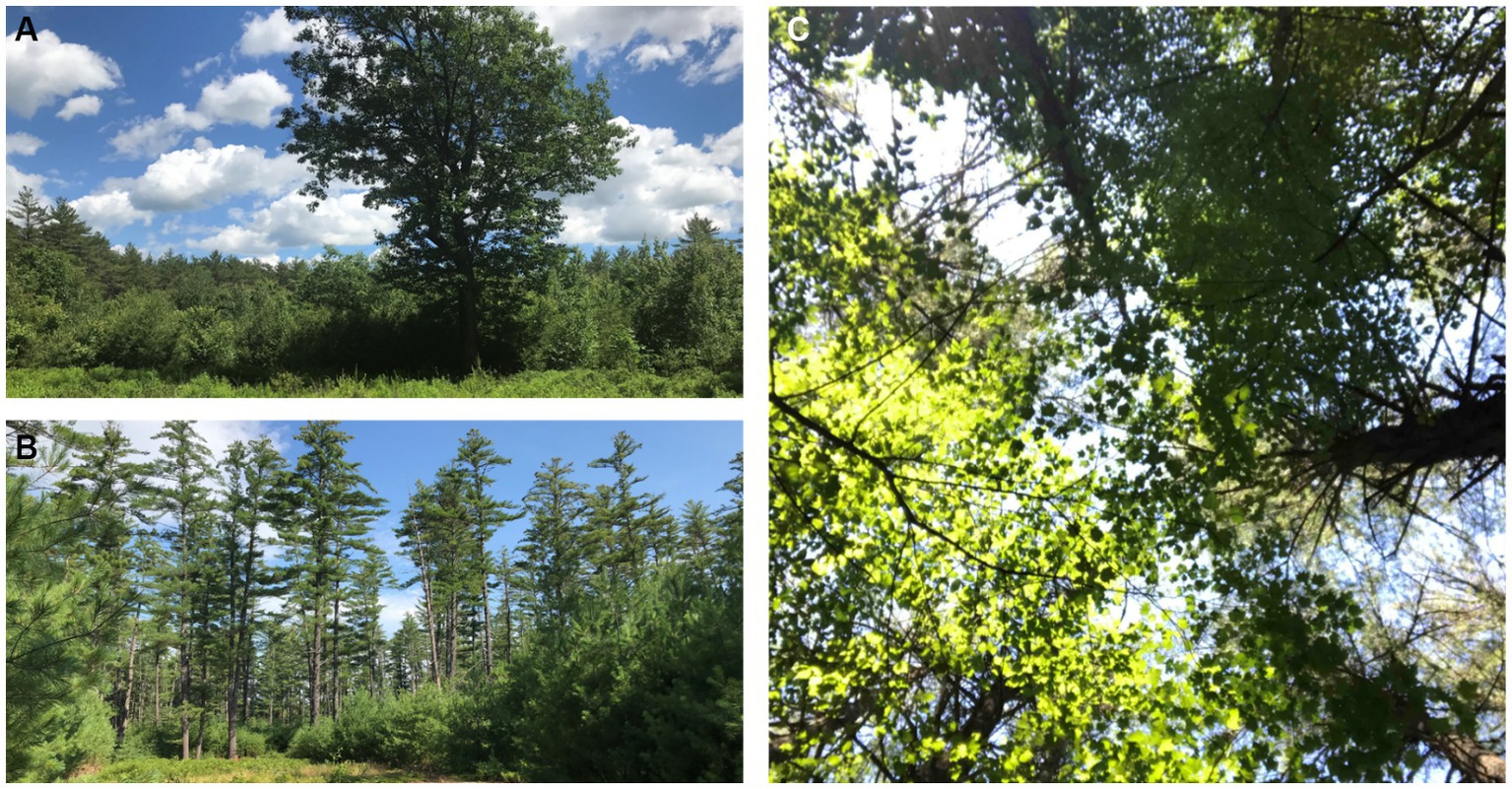
Figure 1. Silvicultural treatments: (A) top left patch cut (1.2 ha opening) at the Massabesic Experimental Forest in Lyman, Maine, (B) bottom left shelterwood, and (C) shaded overstory conditions in an untreated control in Bear Brook State Park, Allentown, New Hampshire.
White pine is also commercially valuable for timber products and aesthetic values for recreational purposes, providing billions of dollars in revenue to local economies (Costanza et al., 2018). However, it is susceptible to a variety of pathogen and insect pests which include, but are not limited to, white pine weevil (Pissodes strobi), white pine blister rust (WPBR, Cronartium ribicola), Caliciopsis canker (Caliciopsis pinea), and foliar diseases such as needle casts and brown spot needle blight (Lecanosticta acicola) (Costanza et al., 2018). White pine weevil is a native insect pest to North America, where it damages Picea and Pinus species by killing the terminal leader, resulting in multi-stemmed growth form and serious lumber defects (Major et al., 2009; Ostry et al., 2010). Vigorously growing trees in full sunlight are more susceptible to damage compared to trees growing in partial shade because weevils attack succulent shoots with thicker bark produced in open conditions (Hamid et al., 1995). In addition, more open conditions increase light and temperature which stimulate the weevils (Hamid et al., 1995). White pine blister rust (WPBR) is lethal to five needle pines in North America and other parts of the world where it has been introduced (Kim et al., 2010). Partial shade and dense stands are also recommended for WPBR management because these conditions lead to self-pruning of lower branches, which are infection courts for the causal agent Cronartium ribicola (Ostry et al., 2010). A two-cut shelterwood is one of the most frequently recommended regeneration methods to avoid weevil and WPBR damage (Lancaster and Leak, 1978; Ostry et al., 2010). The first cut coincides with an abundant seed year removing 40%–60% of the overstory. Abundant seed crops (~4,429 thousand seed per hectare) may occur every three to five years, sometimes seven years (Leak et al., 2020). The second cut takes place 5–10 years later when the seedlings are growing rapidly (Lancaster and Leak, 1978).
Prior to 2010, eastern white pine was managed to reduce losses from white pine blister rust and weevil (Lancaster and Leak, 1978; Ostry et al., 2010). Since then, other native pests and diseases such as brown spot needle blight, Caliciopsis canker, and eastern white pine bast scale have caused unprecedented damage (Mech et al., 2013; Broders et al., 2015; Munck et al., 2015; Schulz et al., 2018a,b; Wyka et al., 2018; Costanza et al., 2019; Cram and Fraedrich, 2022). Although the impacts of silvicultural treatments on residual trees in stands damaged by these diseases have been evaluated (McIntire et al., 2018a,b; Costanza et al., 2019, 2020), the impact of these pests and diseases to regeneration following silvicultural treatments is less understood. For example, reducing stand density by thinning improves residual tree growth and symptom severity in stands affected by Caliciopsis canker and foliar diseases (McIntire et al., 2018a; Costanza et al., 2020). Partial shading and high seedling density recommended to control WPBR and weevil damage (Ostry et al., 2010) may increase humidity in the understory, creating conditions favorable to the reproduction and dispersal of foliar and canker fungal pathogens. In addition, inoculum from overstory trees may exacerbate foliar disease severity of understory seedlings (Wyka et al., 2018). Consequently, our objectives were to evaluate the incidence and severity of insect pests and diseases in white pine stands subjected to the following silvicultural treatments: low density thinnings, patch cuts, shelterwoods, and unmanaged or control stands. Understanding the effects of frequently recommended and implemented silvicultural treatments on insect pest and disease incidence and severity is important to maintain valuable white pine forests.
2. Methods
2.1. Study sites and silvicultural treatments
We evaluated the condition of eastern white pine overstory trees and regeneration in stands under different silvicultural regimes at the Northern Unit of the Massabesic Experimental Forest (MEF) in Lyman, Maine, and Bear Brook State Park (BBSP) in Allenstown, New Hampshire (Table 1). In both sites, white pine stands grow in excessively drained glacial outwash soils where soil moisture is too limited for favorable hardwood growth. These two sites, 90 km apart, are abundantly forested with white pine established in 1940s resulting from natural (BBSP) and artificial regeneration (MEF) methods following agricultural abandonment, fire (MEF), or a hurricane (BBSP). Artificial regeneration involved planting and early removal of hardwoods. At the MEF, patch cuts, a shelterwood, and low-density thinning examples cut in 2007–2008 exist on the Northern unit embedded in a forested landscape matrix created following the 1947 fires. The treatments were accomplished through a timber sale administered by the White Mountain National Forest in the fall of 2007 and 2008 before snow fall when the soil was exposed. White pine regeneration (seedlings and saplings) was achieved by timing harvests coinciding with good white pine seed years and heavy soil scarification from harvesting activities. For example, at the MEF the logging contractor whole-tree harvested the sale area using a tracked feller buncher to drop the trees; and rubber-tired skidder to collect the cut stems and haul them to the landing for processing into logs, pulpwood, and chip products. This practice scarifies the ground surface sufficiently to bury white pine seed that germinates the following spring. Other practices that minimally scarify the ground surface leave white pine seed on the ground exposed to seed predation by foraging birds, squirrels, and small mammals. Experimental forests, such as the MEF, provide the unique infrastructure to conduct long term research where results can be demonstrated to cooperators and stakeholders (Wells et al., 2009).
We visually inspected the health of white pines in stands under different silvicultural regimes: shelterwood (residual basal area of 18 m2 ha−1), patches (1.2 ha openings), low density thinnings (residual basal area of 7 and 14 m2 ha−1, respectively), and no treatment control (>2 ha) (Leak and Lamson, 1999; Leak and Yamasaki, 2013). Patch cuts and low density thinnings were replicated twice at the MEF, but the shelterwood was not. Thus, two additional shelterwoods and an untreated control stand at BBSP were included in the study (Table 1; Figure 1). Lastly, the presence of foliar pathogens, Caliciopsis canker, white pine weevil and blister rust has been documented in both sites allowing us to quantify the effects of silvicultural treatments on damage caused by these agents (Table 1; Figures 1, 2) [McConkey and Smith, 1958; Munck et al., 2016; Wyka et al., 2018; Leak et al., 2020; State of New Hampshire Department of Natural and Cultural Resources (NHDNCR), 2021].
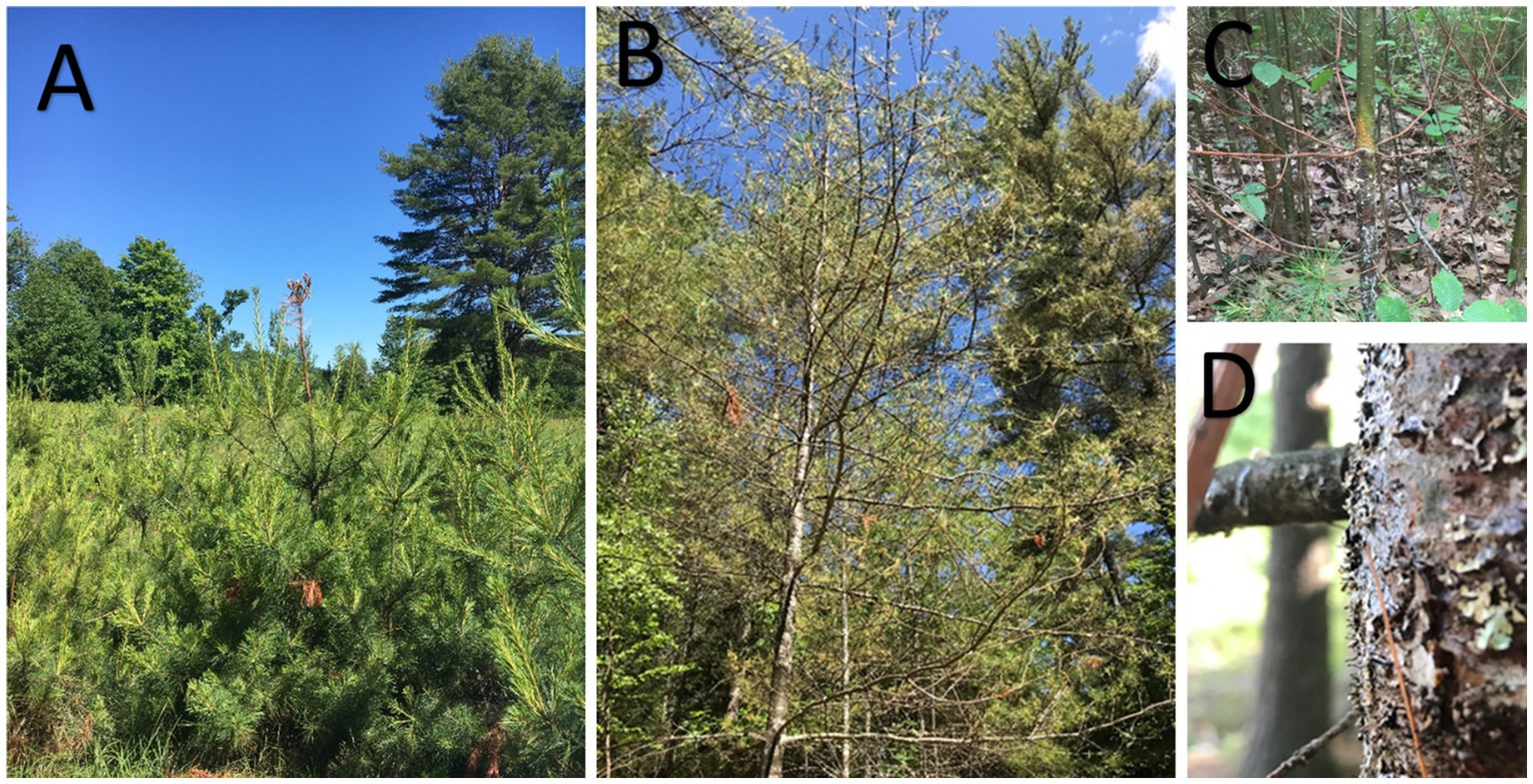
Figure 2. Eastern white pine regeneration in southern Maine and New Hampshire with signs and symptoms of insects and (A) white pine weevil (Pissodes strobi), (B) chlorosis and defoliation caused by Lecanosticta acicola, (C) white pine blister rust stem canker caused by Cronartium ribicola, and (D) fruiting bodies of Caliciopsis pinea protruding from a branch whorl.
2.2. Field measurements
At least two stands per treatment were sampled during the summer of 2020. At each stand, three circular fixed area plots were established per stand with methods like those described by Heuss et al. (2019). To determine plot placement, a map was created using ArcGIS by overlaying a 50 m x 50 m grid on the polygon delineating the stand. A random sampling point within the grid was selected representing the center of the first plot and subsequent plots were selected using the map so that they were at least 50 m apart and well within the stand. At each plot, all trees (≥10 cm dbh = diameter at breast height 1.37 m) within a circular plot with a 10 m radius (314 m2) were evaluated. Tree species and dbh were recorded for each tree. Additionally, for every white pine (P. strobus) the following variables were noted: live crown ratio, crown density, white pine foliar disease rating, incidence (presence) of Caliciopsis canker (fruiting bodies in regeneration or resinosis in trees), WPBR, white pine weevil, and other insects or diseases (Table 2). Tree crown condition is an important indicator of forest health because trees with vigorous crown have more photosynthetic capacity to grow (Randolph et al., 2010). Crown density measures the amount of sunlight blocked by all biomass produced by the tree (Randolph et al., 2010). Live crown ratio (LCR) is the ratio of crown length to total height of the tree (USDA Forest Service Forest inventory and analyses National Program, 2011).
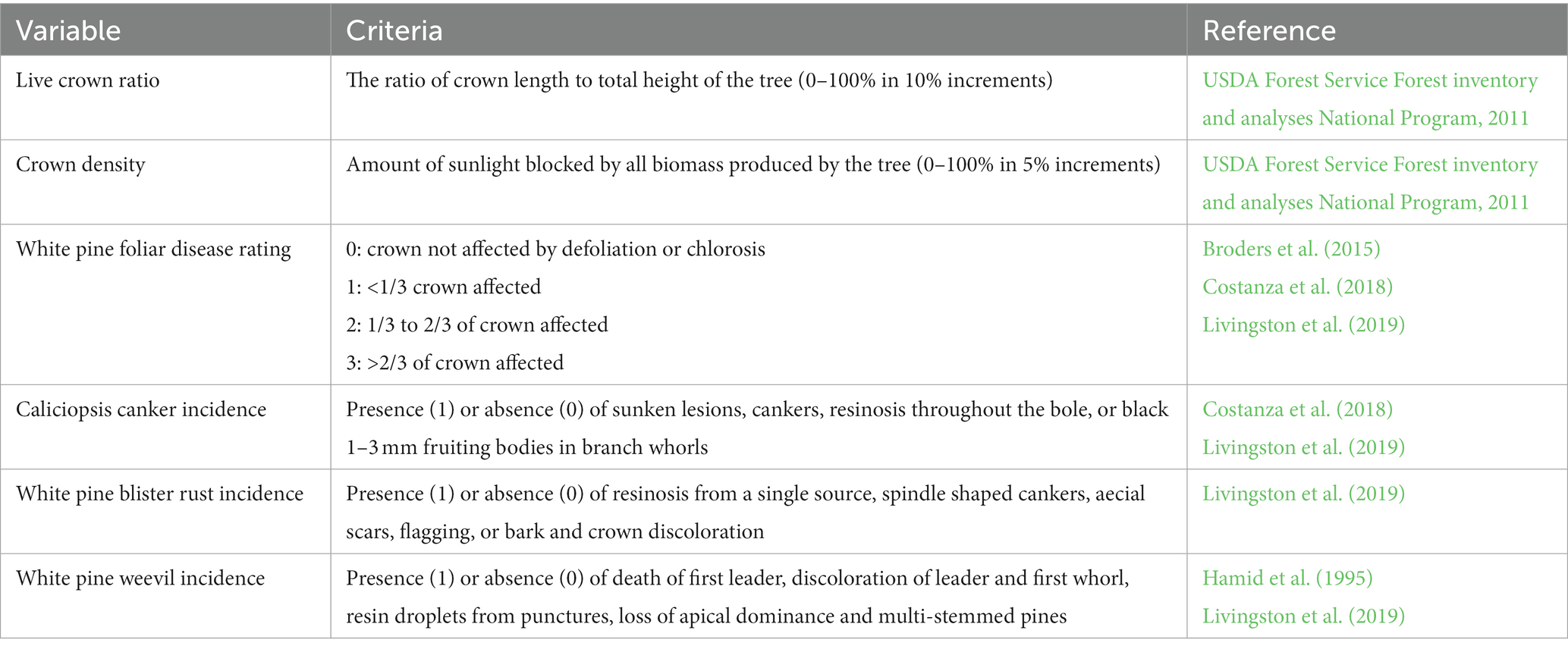
Table 2. Criteria used to evaluate health of eastern white pine trees (dbh > 10 cm) and regeneration (dbh < 10 cm and height > 30 cm).
To evaluate regeneration, two subplots 5 m and at 120 or 240 degrees from plot center relative to north, respectively. At each subplot, canopy cover was measured with the CanopyApp (UNH Earth Systems Research Center), and the total number of seedlings and saplings were tallied within a circular plot with a 2.5 m radius (20 m2). The following additional data was collected for the 10 white pine saplings (2.5 cm > dbh < 10 cm) or seedlings (dbh < 2.5 cm and height > 30 cm) closest to subplot center: dbh, height, live crown ratio (LCR), crown density, white pine foliar disease (WPND) rating, incidence of Caliciopsis canker, WPBR, weevil, and other insects or diseases (Table 2; Figure 2). White pine foliar diseases were assessed on a rating scale from 0 to 3 representing the proportion of the crown in thirds affected (Table 2) (Broders et al., 2015). Symptomatic needles were collected from each stand to confirm presence of foliar pathogens. Needles were stored at 4°C until they were they were incubated in a moist chamber overnight and fruiting structures were inspected under a light microscope (Broders et al., 2015). Only Lecanosticta acicola pycnidia and conidia were observed from samples collected at each site.
2.3. Statistical analyses
One-way analyses of variance (ANOVA) were performed using the GLIMMIX procedure (Statistical Analyses Software v. 9.4, SAS Institute Inc., Cary, NC) to investigate main effects of silvicultural treatments on response variables associated with tree condition listed in the first column of Tables 2, 3: dbh (cm), height of regeneration, live crown ratio, crown density, disease severity of foliar pathogens (WPND severity), and incidence of other diseases and weevil damage. When main effects of treatment were significant (α = 0.05), a Tukey–Kramer test was used to identify differences between means.
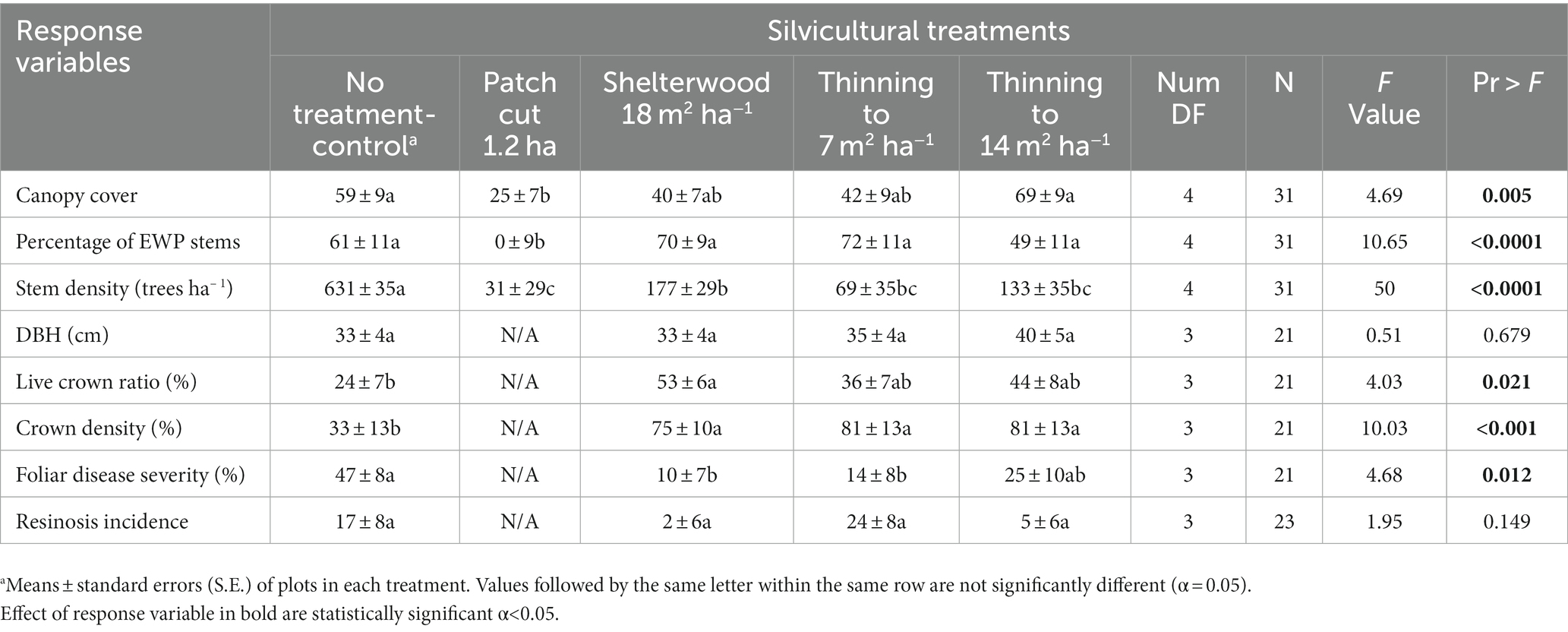
Table 3. Eastern white pine (Pinus strobus) overstory response variables in relation to silvicultural treatments in Maine and New Hampshire.
3. Results
We evaluated and measured eastern white pine trees (262) and regeneration (>500 seedlings and saplings) in 36 plots, three per stand, for 12 stands, at least 2 stands per silvicultural treatment (Table 1). Other tree species present in our plots included: Abies balsamea, Acer rubrum, Betula spp., Fagus grandifolia, Prunus serotina, Picea rubens, Pinus resinosa, Quercus rubra, Q. alba, and Tsuga canadensis. Of these, A. rubrum and Q. rubra were most common (Table 1).
Silvicultural treatments in white pine stands had the intended effects in overstory white pines. These were completely removed from patch cuts, and partially removed from other treatments, thus, stem density was more than four times greater for untreated controls compared to the treated stands (Table 3). Overall, crown condition improved in treated stands compared to controls. For example, crown density of white pines in untreated control stands was significantly less (33%) compared to that in treated stands (>75%) (p < 0.001). Conversely, severity of foliar pathogens was greater for trees in untreated stands (47% crown affected) compared to that in treated stands (<25% crown affected) (p = 0.012). Resinosis, a symptom of WPBR, Caliciopsis canker and other insects and diseases, was low in all treatments (<17% trees affected) and not statistically significant among treatments.
Compared to untreated control stands, treated stands had more and generally larger regeneration (dbh and height) with better crown condition (LCR, crown density, and WPND severity) (Table 4). The untreated controls produced in average 3,042 ha−1 white pine saplings and seedlings compared to >16,000 ha–1 saplings and seedlings for treated stands. The dbh and height of seedlings and saplings in untreated control stands was 0.6 cm and 0.9 m, respectively compared to dbh > 1 cm and height > 1.8 m in treated stands (Table 4). The main effect of some treatments was only marginally (dbh, p = 0.08) or not statistically significant (height, LCR, and crown density) for least square means comparisons among treatments. However, most treatment values were significantly different than the control value in single pair-wise comparisons (α = 0.05) (Table 4).
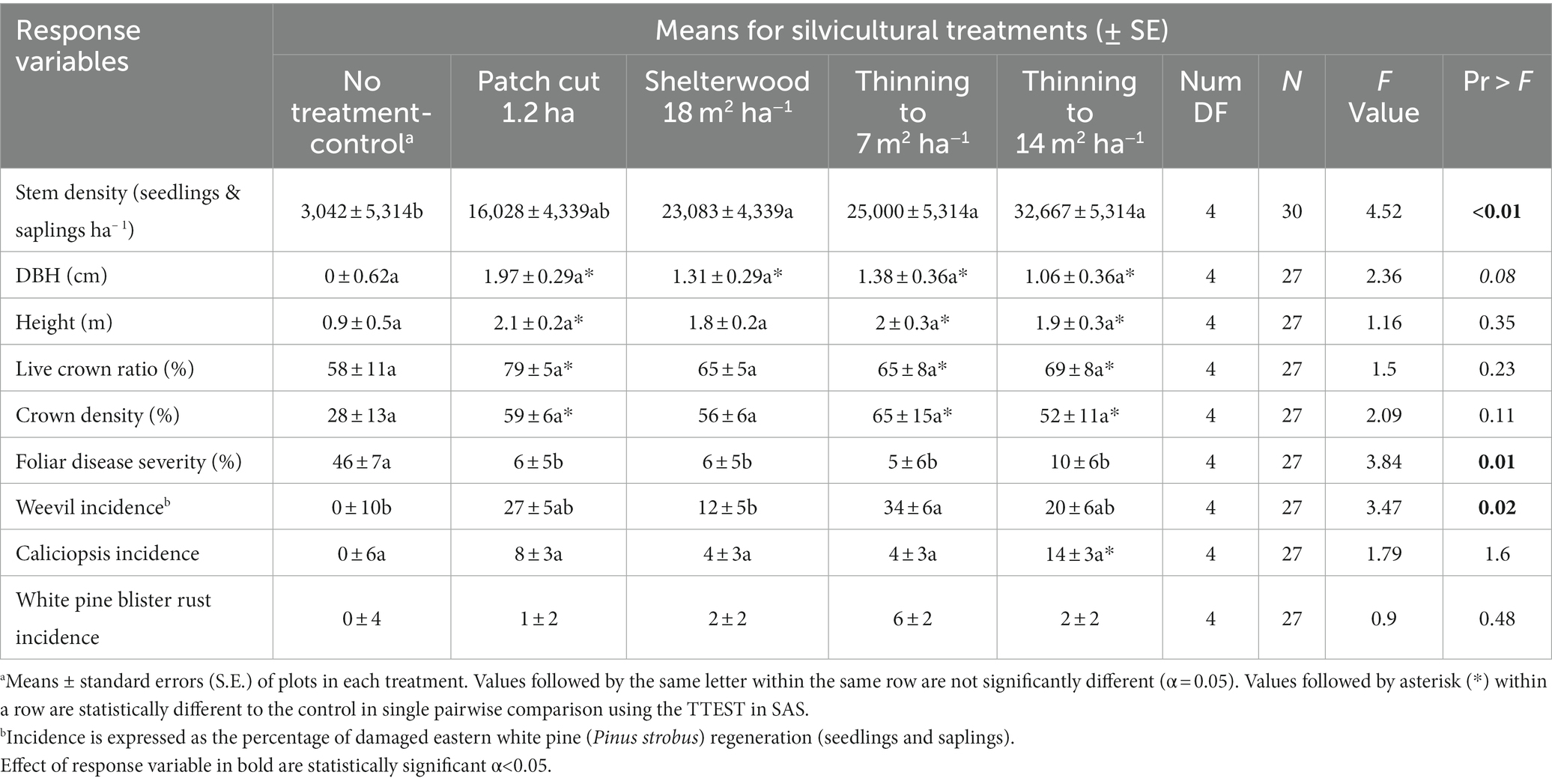
Table 4. Eastern white pine (Pinus strobus) regeneration response variables in relation to silvicultural treatments in Maine and New Hampshire.
As expected, patch cuts and thinning to 7 m2 ha−1, the treatments with least canopy cover (25 and 42%, respectively) or shade, had the greatest proportion of white pine seedlings with weevil damage (27 and 34%, respectively) compared to untreated control stands where regeneration did not have any weevil damage due to heavy shading (Tables 3, 4). Despite the weevil damaged regeneration, patch cuts in this study produced in average > 10,000 white pine seedlings ha−1 without weevil or other pest or insect damage (Figure 3). Similarly, despite more damage from Caliciopsis canker (14%) in thinned stands compared to untreated controls (0%), because regeneration was so abundant in thinned stands (>25,000 seedlings and saplings h−1) compared to untreated stands (3,042 seedlings and saplings h−1), more undamaged regeneration was present in treated stands (Figure 3). White pine blister rust incidence was <6% and not statistically significant among treatments.
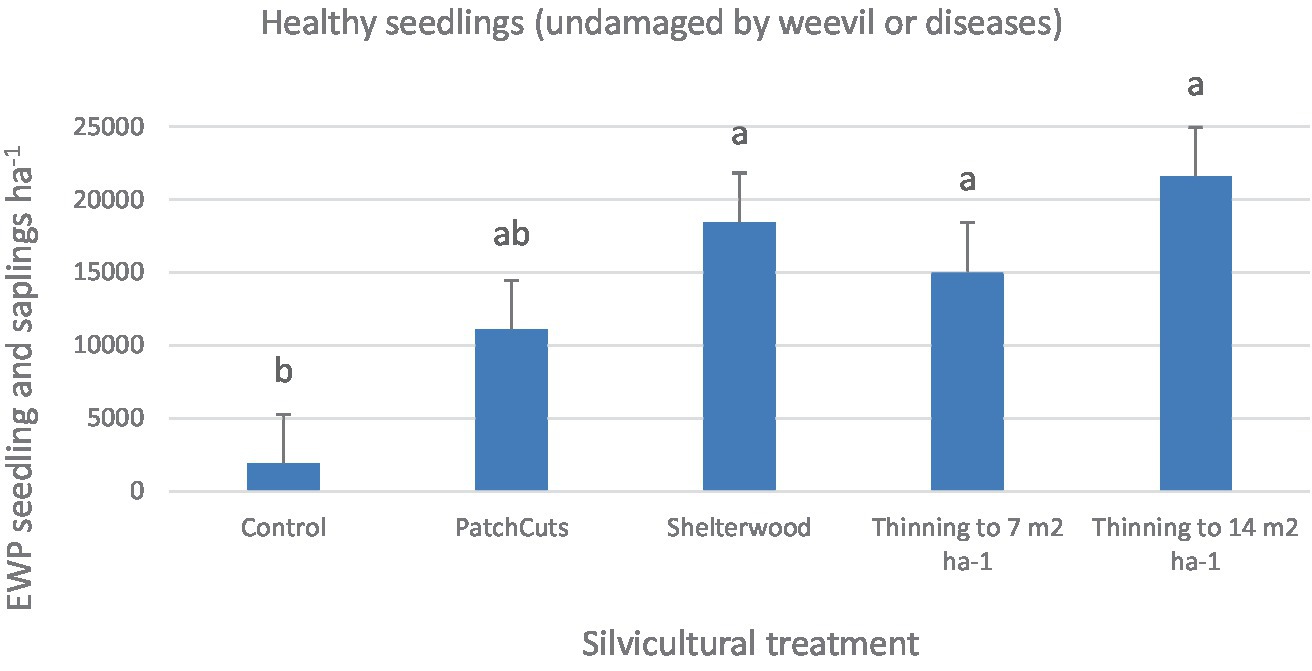
Figure 3. Density of undamaged eastern white pine regeneration in different treatments. Bars represent the mean and standard error for plots within each treatment. Values with the same letter are not statistically different (α = 0.05).
4. Discussion
Host density may facilitate or slow down the development of disease epidemics or pest outbreaks (Asaro et al., 2023) and understanding effects of host density is therefore critical to management of resilient forests. Shelterwoods and low-density thinnings are the most prescribed silvicultural treatments for management of eastern white pine insect pests and diseases (Ostry et al., 2010; Livingston et al., 2019). These treatments can reduce disease incidence and severity at the stand level by improving condition of residual trees and removal of the weakest trees during harvesting operations (McIntire et al., 2018a; Costanza et al., 2020). Harvesting operations to implement these treatments can result in abundant white pine regeneration (Leak and Yamasaki, 2013).
Compared to overstory trees, the relationship between high stem density in regeneration and foliar diseases or Caliciopsis canker is not as well understood. In a previous study, stem density was associated with greater Caliciopsis canker disease severity in white pine overstory trees and regeneration (Munck et al., 2016). Similarly, in this study the thinnings to 14 m2 ha−1 had the greatest Caliciopsis canker incidence and the most abundant regeneration. In this study, both overstory and understory white pines across all silvicultural treatments exhibited less foliar disease severity compared to untreated controls. This finding is consistent with a study by McIntire et al. (2018a) that evaluated crown condition of overstory trees before and after thinning stands.
Foresters and land managers are reluctant to implement clear cuts and patch cuts because white pine weevil preferentially attacks regeneration growing in open conditions. Shading provided by residual trees in shelterwoods reduces white pine weevil damage in the understory (Ostry et al., 2010). In this study, patch cuts and low density thinnings had the least canopy cover and consequently, greatest incidence of weevil damage (Tables 3, 4). Both these treatments, however, yielded abundant white pine regeneration with >10,000 seedlings and sampling per hectare. Defective regeneration could be removed in precommercial thinnings when saplings are 6 m tall to a recommended stem density of 490–740 stem per hectare (Livingston et al., 2019), thus plenty of healthy stems would be available in treated stands evaluated in this study. These low-density treatments have the added benefit of creating early successional habitat preferred by some songbirds.
In Eastern USA, forested land is mostly privately owned. Obtaining support for silvicultural treatments to improve forest health is challenging because private landowners are not solely interested in commercial value of their trees. However, many are interested in wildlife management. Following treatment, shelterwoods and patch cuts produce greater average species richness of birds than unmanaged forest (Goodale et al., 2009; Duguid et al., 2016). These silvicultural treatments create early successional habitat needed by birds using young forests (Costello et al., 2000; Thompson and DeGraaf, 2001; DeGraaf and Yamasaki, 2003; Yamasaki et al., 2014). Thus, shelterwood and patch cut treatments may both increase biodiversity and improve forest production and regeneration.
In conclusion, silvicultural treatments that reduced stem density in the overstory and scarified the soil during harvesting operations resulted in better conditions of residual trees and plenty of healthy white pine regeneration compared to unmanaged stands. Our study emphasizes the importance of considering a realistic spectrum of natural enemies when designing silvicultural operations. Our findings are consistent with management current recommendations for white pine (Livingston et al., 2019; Leak et al., 2020). Given the economic and ecological value of eastern white pine, the effects of silvicultural treatments on insect and pest conditions merit further study. Results could vary in locations where insect pest and disease pressures are greater. This study was conducted in Northeastern USA, but the insect pest and diseases we evaluated have worldwide distribution. For example, white pine blister rust damages pine in Asia, Europe and North America (Geils et al., 2010). Lecanosticta acicola has a global distribution and is a threat to plantations and naturally regenerated stands (van der Nest et al., 2019; Tubby et al., 2023). Pathogenic Caliciopsis spp. damage conifer species in Europe, North America, and Eucalyptus spp. in Australia (Pascoe et al., 2018; Migliorini et al., 2020). Consequently, our findings could be useful to the management of other patho-systems.
Data availability statement
The raw data supporting the conclusions of this article will be made available by the authors, without undue reservation.
Author contributions
MY and JJ designed and implemented silvicultural treatments, respectively. IM and JJ conceived and designed the data collection. IM analyzed the data and prepared the manuscript. All authors contributed to the article and approved the submitted version.
Funding
This project was funded by the USDA Forest Service.
Acknowledgments
We thank the USDA Northern Research Station and State of New Hampshire Department of Natural and Cultural Resources (NHDNCR) for access to the Massabesic Experimental Forest and Bear Brook State Park, respectively. We are thankful for field assistance and hard work from Tyler Brodie, Owen Price, River Mathieu and Kevin Dodds. We are grateful for the assistance of NHDNCR staff specially William Guinn, Kyle Lombard, Billy Kunelius, Scott Rolfe, and Robert Spoerl. We greatly appreciate guidance from Bill Leak, Ken Desmarais, and Rebecca Lilja (USFS), and Mark Ducey (UNH). Thank you for the comments and edits of two reviewers and the editor that have improved the quality of the manuscript.
Conflict of interest
The authors declare that the research was conducted in the absence of any commercial or financial relationships that could be construed as a potential conflict of interest.
Publisher’s note
All claims expressed in this article are solely those of the authors and do not necessarily represent those of their affiliated organizations, or those of the publisher, the editors and the reviewers. Any product that may be evaluated in this article, or claim that may be made by its manufacturer, is not guaranteed or endorsed by the publisher.
References
Asaro, C., Koch, F. H., and Potter, K. M. (2023). Denser forests across the USA experience more damage from insects and pathogens. Sci. Rep. 13:3666. doi: 10.1038/s41598-023-30675-z
Broders, K., Munck, I., Wyka, S., Iriarte, G., and Beaudoin, E. (2015). Characterization of fungal pathogens associated with white pine needle damage (WPND) in northeastern North America. Forests 6, 4088–4104. doi: 10.3390/f6114088
Costanza, K. K. L., Crandall, M. S., Rice, R. W., Livingston, W. H., Munck, I. A., and Lombard, K. (2019). Economic implications of a native tree disease, Caliciopsis canker, on the white pine (Pinus strobus) lumber industry in the northeastern United States. Can. J. For. Res. 49, 521–530. doi: 10.1139/cjfr-2018-0380
Costanza, K. K. L., Livingston, W. H., Fraver, S., and Munck, I. A. (2020). Dendrochronological analyses and whole-tree dissections reveal Caliciopsis canker (Caliciopsis pinea) damage associated with the declining growth and climatic stressors of eastern white pine (Pinus strobus). Forests 11:347. doi: 10.3390/f11030347
Costanza, K. K. L., Whitney, T. D., McIntire, C. D., Livingston, W. H., and Gandhi, K. J. K. (2018). A synthesis of emerging health issues of eastern white pine (Pinus strobus) in eastern North America. For. Ecol. Manag. 423, 3–17. doi: 10.1016/j.foreco.2018.02.049
Costello, C. A., Yamasaki, M., Pekins, P. J., Leak, W. B., and Neefus, C. D. (2000). Songbird response to group selection harvests and clearcuts in a New Hampshire northern hardwood forest. For. Ecol. Manag. 127, 41–54. doi: 10.1016/S0378-1127(99)00131-0
Cram, M. M., and Fraedrich, S. W. (2022). Effects of Caliciopsis pinea inoculation with and without wounding on Pinus strobus. For. Pathol. 52:e12733. doi: 10.1111/efp.12733
DeGraaf, R. M., and Yamasaki, M. (2003). Options for managing early-successional forest and shrubland habits in the northeastern United States. For. Ecol. Manag. 185, 179–191. doi: 10.1016/S0378-1127(03)00254-8
DeGraaf, R. M., Yamasaki, M., Leak, W. B., and Lester, A. M. (2006). Technical guide to Forest wildlife habitat Management in new England. Burlington, VT: University of Vermont Press. 305 p.
Duguid, M. C., Morrell, E. H., Goodale, E., and Ashton, M. S. (2016). Changes in breeding bird abundance and species composition over a 20-year chronosequence following shelterwood harvest in oak hardwood forests. For. Ecol. Manag. 376, 221–230. doi: 10.1016/j.foreco.2016.06.010
Geils, B. W., Hummer, K. E., and Hunt, R. S. (2010). White pines, Ribes, and blister rust: a review and synthesis. For. Pathol. 40, 147–185. doi: 10.1111/j.1439-0329.2010.00654.x
Goodale, E., Lalbhai, P., Goodale, U. M., and Ashton, P. M. S. (2009). The relationship between shelterwood cuts and crown thinnings and the abundance and distribution of birds in a southern New England forest. For. Ecol. Manag. 258, 314–322. doi: 10.1016/j.foreco.2009.04.020
Hamid, A., O'Dell, T. M., and Katovich, S. (1995). “White pine weevil” in Forest insect and disease leaflet 21. ed. USDA Forest Service. (Broomall (PA): U.S. Department of Agriculture, Forest Service. Northern Area State & Private Forestry)
Heuss, M., D’Amato, A. W., and Dodds, K. J. (2019). Northward expansion of southern pine beetle generates significant alterations to forest structure and composition of globally rare Pinus rigida forests. For. Ecol. Manag. 434, 119–130. doi: 10.1016/j.foreco.2018.12.015
Kim, M.-S., Klopfenstein, N. B., Ota, Y., Lee, S. K., Woo, K.-S., and Kaneko, S. (2010). White pine blister rust in Korea, Japan and other Asian regions: comparisons and implications for North America. For. Pathol. 40, 382–401. doi: 10.1111/j.1439-0329.2010.00664.x
Lancaster, K. F., and Leak, W. B. (1978). A silvicultural guide for white pine in the northeast. USDA For. Serv. Gen. Tech. Rep. Broomall, PA: USDA Forest Service, Northern Research Station NE-41, –13.
Leak, W. B., and Lamson, N. I. (1999). Revised white pine stocking guide for managed stands. Na-TP-01-99. Newtown Square, PA: U.S. Department of Agriculture, Forest Service, Northeastern Area State and Private Forestry, 2.
Leak, W. B., and Yamasaki, M. (2013). Effects of low-density thinning in a declining white pine stand in Maine. Res. Note NRS-170. Newtown Square, PA: U.S. Department of Agriculture, Forest Service, Northern Research Station. p.6
Leak, W. B., Yamasaki, M., Bennett, K. P., Desmarais, K., Pohl, P., Costello, C., et al. (2020). White pine silviculture for timber and wildlife habitat in New England. University of New Hampshire Cooperative Extension, Durham, NH. 34 p.
Livingston, W. H., Munck, I., Lombard, K., Weimer, J., Bergdahl, A., Kenefic, L. S., et al. (2019). Field manual for managing eastern white pine health in New England University of Maine, Maine Agric. And for. Exp. Sta., Orono ME: Misc. pub. 764, 20.
Major, J. E., Mosseler, A., Barsi, D. C., Clouthier, A., and Campbell, M. (2009). Impact of three silvicultural treatments on weevil incidence, growth, phenology, and branch-leveldynamics of Pinus strobus from large and small populations. Can. J. For. Res. 39, 12–25. doi: 10.1139/X08-153
McConkey, T. W., and Smith, W. E. (1958). The Massabesic experimental Forest. Station paper NE-108. Upper Darby, PA: U.S. Department of Agriculture, Forest Service, Northeastern Forest Experiment Station. p 19
McIntire, C. D., Munck, I. A., Ducey, M. J., and Asbjornsen, H. (2018a). Thinning treatments reduce severity of foliar pathogens in eastern white pine. For. Ecol. Manag. 423, 106–113. doi: 10.1016/j.foreco.2018.03.032
McIntire, C. D., Munck, I. A., Vadeboncoeur, M. A., Livingston, W. H., and Asbjornsen, H. (2018b). Impacts of white pine needle damage on seasonal litterfall dynamics and wood growth of eastern white pine (Pinus strobus) in northern New England. For. Ecol. Manag. 423, 27–36. doi: 10.1016/j.foreco.2018.02.034
Mech, A. M., Asaro, C., Cram, M. M., Coyle, D. R., Gullan, P. J., Cook, L. G., et al. (2013). Matsucoccus macrocicatrices (Hemiptera: Matsucoccidae): first report, distribution, and association with symptomatic eastern white pine in the southeastern United States. J. Econ. Entomol. 106, 2391–2398. doi: 10.1603/EC13251
Migliorini, D., Luchi, N., Pepori, A. L., Pecori, F., Aglietti, C., Maccioni, F., et al. (2020). Caliciopsis moriondi, a new species for a fungus long confused with the pine pathogen C. pinea. Mycokeys 73, 87–108. doi: 10.3897/mycokeys.73.53028
Munck, I., Livingston, W., Lombard, K., Luther, T., Ostrofsky, W., Weimer, J., et al. (2015). Extent and severity of Caliciopsis canker. An emerging disease of eastern white pine (Pinus strobus L.). Forests 6, 4360–4373. doi: 10.3390/f6114360
Munck, I. A., Luther, T., Wyka, S., Keirstead, D., McCracken, K., Ostrofsky, W., et al. (2016). Soil and stocking effects on Caliciopsis canker of Pinus strobus L. Forests 7:269. doi: 10.3390/f7110269
Ostry, M. E., Laflamme, G., and Katovich, S. A. (2010). Silvicultural approaches for management of eastern white pine to minimize impacts of damaging agents. For. Pathol. 40, 332–346. doi: 10.1111/j.1439-0329.2010.00661.x
Pascoe, I. G., McGee, P. A., Smith, I. W., Dinh, S. Q., and Edwards, J. (2018). Caliciopsis pleomorpha sp. nov. (Ascomycota: Coryneliales) causing a severe canker disease of Eucalyptus cladocalyx and other eucalypt species in Australia. Fungal Syst Evol 5, 197–281. doi: 10.3114/fuse.2020.05.13
Randolph, K. C., Morin, R. S., and Steinman, J. (2010). Descriptive statistics of tree crown condition in the northeastern United States. Gen. Tech. Rep. SRS-124. Asheville, NC: U.S. Department of Agriculture, Forest Service, southern Research Station. 21 p.
Schulz, A. N., Mech, A. M., Asaro, C., Coyle, D. R., Cram, M. M., Lucardi, R. D., et al. (2018a). Assessment of abiotic and biotic factors associated with eastern white pine (Pinus strobus L.) dieback in the southern Appalachian Mountains. For. Ecol. Manag. 423, 59–69. doi: 10.1016/j.foreco.2018.02.021
Schulz, A. N., Mech, A. M., Cram, M. M., Asaro, C., Coyle, D. R., Lucardi, R. D., et al. (2018b). Association of Caliciopsis pinea peck and Matsucoccus macrocicatrices Richards with eastern white pine (Pinus strobus L.) seedling dieback. For. Ecol. Manag. 423, 70–83. doi: 10.1016/j.foreco.2018.03.013
Seymour, R. S. (2007). Low-density management of white pine crop trees: a primer and early research results. North. J. Appl. For. 24, 301–306. doi: 10.1093/njaf/24.4.301
State of New Hampshire Department of Natural and Cultural Resources (NHDNCR) . (2021). Bear brook State Park management plan. Available at: https://www.nhstateparks.org/getmedia/e2880baa-0ba5-470c-ab30-43a158d2ca42/Bear-Brook-SP_Mgt-Plan-2021_final.pdf (Accessed 11 June, 2023)
Thompson, F. R., and DeGraaf, R. M. (2001). Conservation approaches for woody, early successional communities in the eastern United States. Wildl. Soc. Bull. 29, 483–494.
Tubby, K., Adamčikova, K., Adamson, K., Akiba, M., Barnes, I., Boroń, P., et al. (2023). The increasing threat to European forests from the invasive foliar pine pathogen, Lecanosticta acicola. For Ecol Manage 536:120847. doi: 10.1016/j.foreco.2023.120847
USDA Forest Service Forest inventory and analyses National Program, (2011). Phase 3 field guide version 5.1. Available at: https://www.fia.fs.usda.gov/library/field-guides-methods-proc/docs/2012/field_guide_p3_5-1_sec23_10_2011.pdf (Accessed August 30, 2023).
van der Nest, A., Wingfield, M. J., Janoušek, J., and Barnes, I. (2019). Lecanosticta acicola: a growing threat to expanding global pine forests and plantations. Molecular Plant Pathol. 20, 1327–1364. doi: 10.1111/mpp.12853
Wells, G., Hayes, D., Krause, K., Bartuska, A., LeVan-Green, S., Anderson, J., et al. (2009). Experimental forests and ranges: 100 years of research success stories. General Technical Report FPL-GTR-182. Madison, WI: USDA-Forest Service, Forest Products Laboratory, 29
Wyka, S. A., McIntire, C. D., Smith, C., Munck, I. A., Rock, B. N., Asbjornsen, H., et al. (2018). Effect of climatic variables on abundance and dispersal of Lecanosticta acicola spores and their impact on defoliation on eastern white pine. Phytopathology 108, 374–383. doi: 10.1094/PHYTO-02-17-0065-R
Yamasaki, M. (2003). “White pine as wildlife habitat” in Managing white pine in a new millennium 2003 workshop proceedings, 2003 October 9–10, Hillsborough, NH. ed. N. H. Durham (University of New Hampshire Cooperative Extension), 33–36.
Keywords: forest management, invasive forest pathogens, host density, white pine weevil, forest diseases
Citation: Munck IA, Yamasaki M and Janelle J (2023) Silvicultural treatments improve pest and disease conditions of white pine (Pinus strobus) residual trees and regeneration. Front. For. Glob. Change. 6:1239835. doi: 10.3389/ffgc.2023.1239835
Edited by:
Juan A. Martin, Polytechnic University of Madrid, SpainReviewed by:
Frank H. Koch, Forest Service (USDA), United StatesJohanna Witzell, Linnaeus University, Sweden
Copyright © 2023 Munck, Yamasaki and Janelle. This is an open-access article distributed under the terms of the Creative Commons Attribution License (CC BY). The use, distribution or reproduction in other forums is permitted, provided the original author(s) and the copyright owner(s) are credited and that the original publication in this journal is cited, in accordance with accepted academic practice. No use, distribution or reproduction is permitted which does not comply with these terms.
*Correspondence: Isabel Alvarez Munck, aXNhYmVsLm11bmNrQHVzZGEuZ292
†These authors have contributed equally to this work and share first authorship
 Isabel Alvarez Munck
Isabel Alvarez Munck Mariko Yamasaki
Mariko Yamasaki Jon Janelle
Jon Janelle